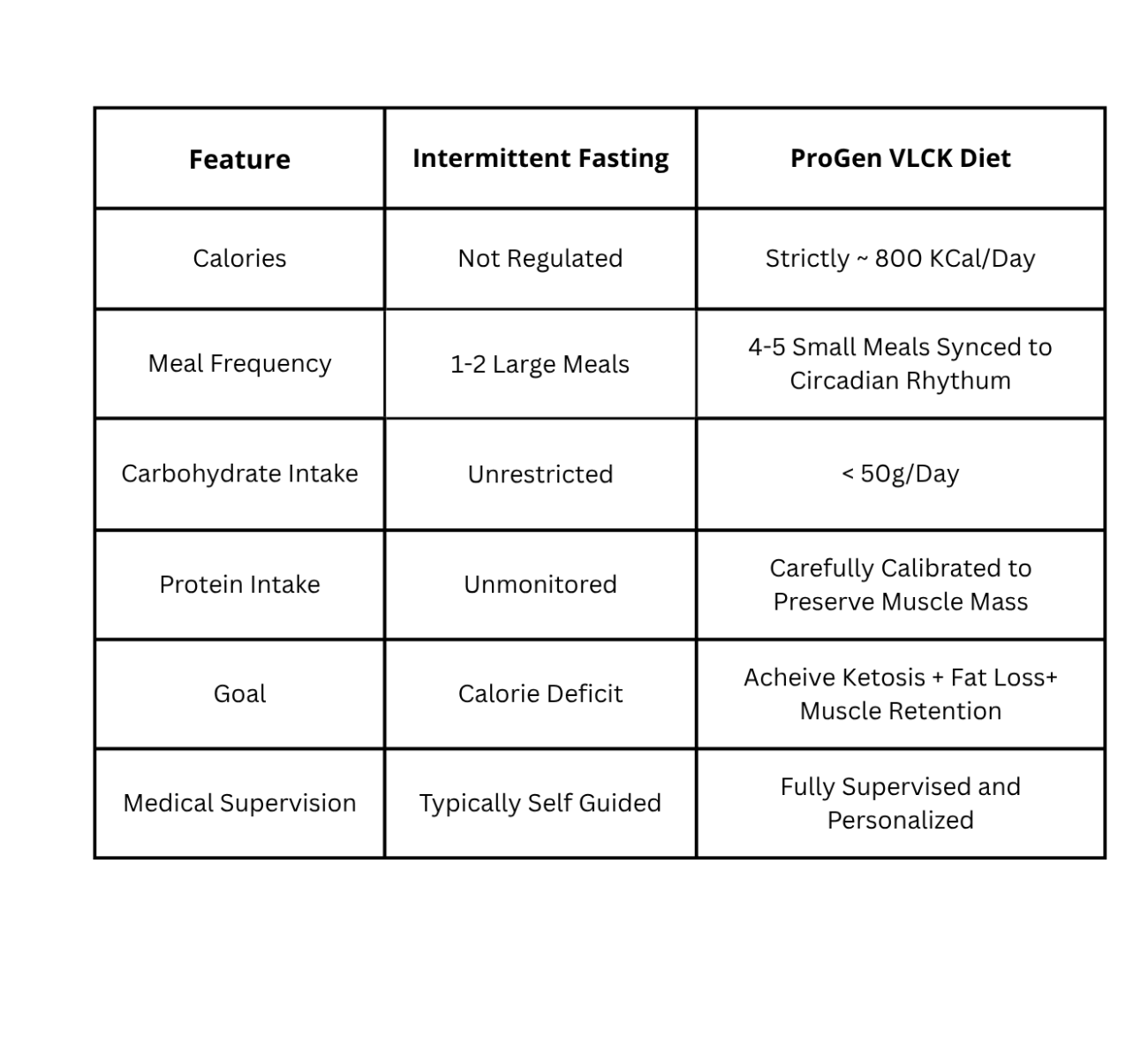
Table of Contents
In the world of weight loss, two approaches dominate the conversation: Intermittent Fasting (IF) and the ProGen Very Low-Calorie Ketogenic Diet (VLCKD). While both methods promise fat loss, they differ significantly in how the body uses energy, preserves muscle mass, and maintains long-term results.
If you’re looking for a structured plan that’s scientifically backed, medically guided, and results-driven, keep reading to learn how ketosis, glucose metabolism, and meal timing all play a critical role.
What is Ketosis and How Does It Help You Lose Weight?
Ketosis is a metabolic state where your body uses fat instead of glucose (sugar) as its primary energy source. When you restrict carbohydrates to less than 50 grams/day, your body runs out of quick energy from glucose. As a result, it turns to stored fat, breaking it down into ketone bodies, which then fuel your brain and muscles.
How Ketosis Aids in Weight Loss?
- Burns stored body fat for energy.
- Suppresses appetite by lowering the hunger hormone ghrelin.
- Enhances mental clarity and energy levels.
- Preserves lean muscle mass (when protein intake is controlled).
- Reduces insulin spikes and improves fat metabolism.
👉 Learn how ProGen’s VLCKD program induces safe and sustained ketosis on our Ketogenic Approach page.
What Is the Role of Ketosis in Intermittent Fasting?
Intermittent Fasting (IF) doesn’t aim to induce ketosis—but under certain conditions, mild ketosis can occur. IF is based on meal timing, not macronutrient control. For example, in the popular 16:8 method (16-hour fast, 8-hour eating window), your body may enter short bursts of ketosis during the fasting phase if carbohydrate intake is low and the fasting window is long enough.
But here’s the catch:
To truly sustain ketosis, your body needs consistent carbohydrate restriction, adequate protein, and moderate fats—which IF doesn’t enforce. So while intermittent fasting can promote weight loss through calorie deficit, it cannot reliably induce or maintain nutritional ketosis.
IF vs. ProGen: Meal Frequency & Diet Restriction Differences

👉 Explore the structured phases of the ProGen Program.
What Are Glucose, Glycogen, and Glucagon?
Understanding your body’s energy system is key to smart weight loss:
1. Glucose:
The body’s primary energy source, derived from carbs. Stored in the bloodstream.
2. Glycogen:
Stored form of glucose found in your liver and muscles. The body uses glycogen when glucose is unavailable.
3. Glucagon:
A hormone that signals the liver to break down glycogen into glucose when blood sugar drops, especially during fasting or low-carb intake.
In ketosis, glucose and glycogen are depleted, prompting your body to shift to fat-burning mode.
How Long Fasting Reduces Cortisol (Stress Hormones)?
Cortisol is a hormone released in response to stress. When you do Stress Eating– especially sugar and processed foods—your body is under constant metabolic stress.
Here’s how fasting (or a controlled low-carb plan like ProGen) reduces cortisol
- Allows the digestive system to rest.
- Improves insulin sensitivity
- Reduces oxidative stress.
- Lowers systemic inflammation.
Think of it like this: your digestive system is like a student. If it studies (digests food) all day without a break, it becomes stressed.
But when given rest (fasting), it functions better and is less anxious.
Health Benefits of Intermittent Fasting
Although IF doesn’t guarantee ketosis, it has notable benefits when done correctly:
- Encourages caloric restriction
- Supports mental clarity and focus
- Initiates autophagy (clearing out damaged cells)
- Reduces bad cholesterol (LDL)
- Improves insulin sensitivity.
- Can aid in managing type 2 diabetes.
But without food quality control, you may still lose muscle or regain fat post-fast.
Why the ProGen Method Works Better for Serious Fat Loss?
The ProGen VLCK Diet goes beyond time-restricted eating. It delivers real fat loss through:
- Scientific formulation of meals with removed carbohydrates.
- Muscle-preserving protein intake tailored to your ideal weight.
- Medical support for those with PCOD, blood pressure, and insulin resistance.
- Hormonal balance through ketosis, reduced hunger signals, and lower cortisol.
- Structured maintenance plan post-diet to prevent weight regain.
Read our client stories to see real-life transformations.
Final Verdict: Which One Should You Choose?
Choose Intermittent Fasting if:
- You have strong discipline.
- You prefer flexibility.
- You have minimal weight to lose.
Choose ProGen if:
- You want rapid, healthy fat loss.
- You struggle with insulin resistance or PCOS.
- You need accountability and structure.
- You want to preserve lean muscle mass.
FREQUENTLY ASKED QUESTIONS
Yes. ProGen’s VLCKD approach burns fat more effectively by inducing ketosis, protecting muscle, and offering medical supervision.
Absolutely. ProGen is ideal for women with PCOS and those struggling with insulin-related weight gain.
It can — especially if you don’t monitor protein intake. ProGen’s diet ensures muscle preservation while losing fat.
Yes. It’s a doctor-guided, evidence-based plan tailored to your health profile.
Yes, but only under medical supervision. While both involve timing and fat burning, combining them without guidance may lead to fatigue or muscle loss. ProGen’s structured VLCKD already mimics fasting benefits while protecting your metabolism — so adding fasting may not be necessary for most people.

About Author – Asma Siddiqua
Asma Siddiqua is a Senior Consultant and Clinical Dietitian at ProGen Weight Management with over 5 years of experience in managing obesity and related co-morbidities. She specializes in reversing diabetes and helping clients achieve and maintain healthy body fat percentages. Asma is dedicated to providing personalized, evidence-based dietary guidance to support sustainable weight loss and improved overall health.


